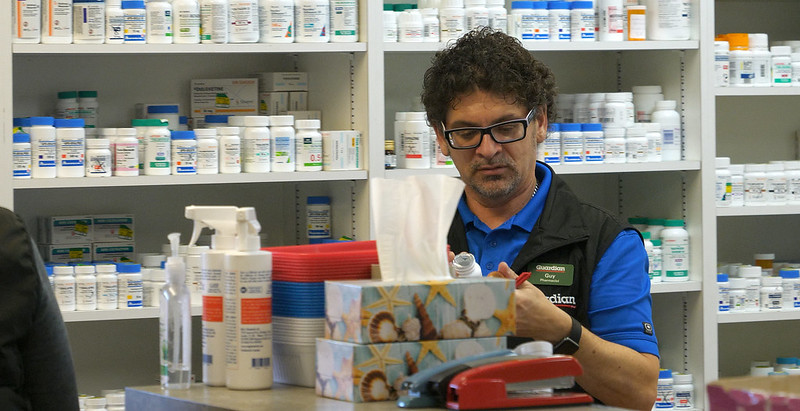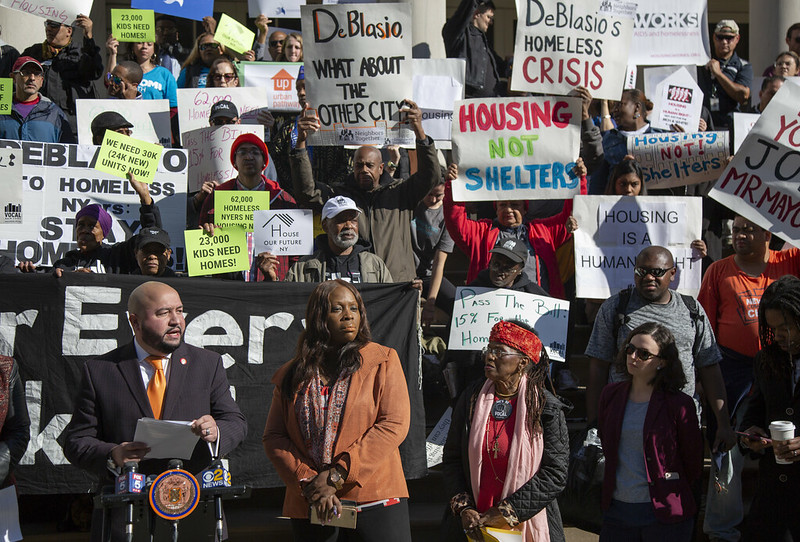PBMs Advocate for New York Consumers to Reduce Prescription Drug Costs

(photo: @albertarpap)
As the debate over prescription drug costs continues, it’s important to understand the role pharmacy benefit managers (PBMs) play in our health care system. Simply put, PBMs are the companies that are driving down prescription drug costs for New Yorkers and consumers nationwide.
PBMs are widely recognized for reducing prescription drug costs, but PBMs should also be recognized for improving clinical outcomes for patients. For example, PBMs perform a sophisticated evaluation of clinical evidence to construct prescription drug formularies that best fit the needs of patients. These prescription drug formularies lead to improved adherence for consumers and better health outcomes overall.
From a pure cost perspective, without PBMs consumers would pay on average $941 more per year per person, according to a 2016 Visante report. In addition, the report showed that over a 10-year period, PBMs will save New York’s consumers and health care programs nearly $40 billion.
PBMs achieve these savings by negotiating directly with drug manufacturers, who alone set and raise prices. The savings achieved by PBMs are used to lower premiums for all consumers in a health plan, or to reduce costs that consumers pay at the pharmacy counter.
Furthermore, any charge that PBMs are opposed to transparency is inaccurate. The fact is PBMs support transparency that leads to better health care outcomes. PBMs provide real-time benefit tools, so patients and their doctors understand which drugs are available and most affordable. In addition, PBMs provide information to clients on contracting terms, including how PBMs are paid for their services.
While it’s clear PBMs are reducing prescription drug costs, we understand that for too many people the costs are simply too high. For that reason, we encourage Governor Cuomo to look closely at whether recently passed legislation (S.6531) will lower health care costs for New Yorkers. In its current form, the bill eliminates many of the cost-saving tools PBMs employ to help keep consumer costs down and improve care.
The legislation puts consumer safety at risk by removing specialty pharmacy accreditation standards, and limits access to cost-effective drugs in favor of more expensive prescriptions. An analysis by Visante shows the bill would lead to $28 billion in additional prescription drug spending in New York over the next 10 years.
PBMs’ core mission is to advocate for consumers in the fight to reduce prescription drug costs. Increasing competition in the market and expanding PBMs’ cost-reducing tools is the best way to address the problem of high drug costs. Where there is sufficient competition, PBMs have a proven track record of success of lowering drug prices.
We’re committed to working with Governor Cuomo and members of the Legislature to address the prescription drug affordability problem where it exists and bring down drug costs and increase access for all New Yorkers.
***
JC Scott is President and CEO of the Pharmaceutical Care Management Association. On Twitter @pcmanet.
***
Have an op-ed idea or submission for Gotham Gazette? Email This email address is being protected from spambots. You need JavaScript enabled to view it.
Making the Democratic State Committee More Democratic and New York's DNC Delegation More Representative

(photo: New York Democratic Party)
With 2020 approaching and a contentious Democratic presidential primary underway, all eyes are the Democratic National Committee (DNC) and its shepherding of the Demcoratic Party apparatus. Far fewer eyes are the Democratic State Committees, constituted in each state, which select the rarefied membership of the National Committee every four years.
In many states, State Committees are a big deal. They are the primary strategic planner for their party’s political efforts, and a key conduit for funding to candidates and local organizations. In New York, not so much. This is largely a function of the State Party’s leadership, and that attitude is well reflected in the State Committee’s picks for New York State’s DNC representatives.
In the DNC, each state is awarded representation through the state party’s Chair and Vice Chair, as well as members apportioned by a formula that accounts for population, Democratic Party enrollment, and votes cast for the Demcoratic candidate in the most recent presidential election. As a large, Democratic state, New York has a large voice on the DNC. The state’s influence is also felt in the fact that two of the DNC’s Vice Chairs, elected by the DNC members, are New Yorkers, further boosting its vote total.
As an influential, ethnically diverse state with a population almost evenly split between urban and non-urban residents, New York is uniquely positioned to champion a Democratic message that appeals to a broad swath of Americans. It’s hard to believe it does this, though, given the chosen composition of the state’s DNC delegation.
Of New York’s 11 elected members of the Democratic National Committee: zero are under 50 years old, though such New Yorkers are about 60% the state population; zero are from upstate, home to about 40% of New York’s population; zero are Hispanic, though about 20% of New York’s population is Hispanic; and zero are Asian, about 10% of New York’s population.
New York’s dismal failure in representation is meaningful, but it would be hard to know it. The DNC makes it extremely difficult for people to acquire the voting records of DNC decisions. An attempt to uncover how New York’s delegation voted on holding a climate debate and issue-based forums in the current presidential primary ran into an initial dead end with the New York State Committee, which says it doesn’t ask members how they vote, and the DNC, which says it only tells DNC members the voting results. This all seems odd for a body whose members are theoretically elected by, and responsible to, State Committees.
Ultimately, I obtained the rolls and they reveal that of New York’s 15 members (including those not elected by the State Committee), only two voted in favor of the holding a climate debate. Perhaps more shockingly, only eight of those who cast votes were there in person (it cannot be determined if the six New Yorkers who didn’t cast votes were present, though it seems likely they were both absent and without a proxy since they were not counted as abstentions). Regardless of how one feels about the climate debate, it seems likely that a different composition of the DNC delegation -- one more diverse, younger and engaged -- could have changed the vote total as well as the number of delegates that attended the meeting.
Last year, one of New York’s DNC seats was left vacant by the passing of Assemblymember Denny Farrell. On October 15, at their fall meeting, the State Committee selected his replacement. In the end, three candidates from Upstate New York ran: Buffalo Mayor Byron Brown, State Committeewoman Kelleigh McKenzie, and State Committeewoman Elisa Sumner. Brown, who also served as Governor Cuomo’s heavy-handed Chair of the State Committee until he was ousted after the 2018 scandal involving a mailer falsely smearing Cuomo’s primary opponent, won with over 60% of the vote.
While the election of an African-American man from Upstate is a step in the right direction, it remains palpably insufficient. African-Americans are the only minority group adequately represented in the DNC delegation while a single upstate member shortchanges nearly half the state’s population -- particularly the part most experienced in winning elections against Republicans.
Brown’s election also represents a continuation of the political status quo. As a long-term ally of Governor Cuomo and a State Chair who often ignored the democratic process, Brown’s ascension to the DNC is likely to maintain New York’s support for business as usual.
If people feel detached from the mechanics of the Democratic Party, they needn’t. In 2020 voters will have a chance to elect their State Committee members -- one male and one female per Assembly District. Those members will then immediately meet to select New York’s DNC members. In the past, the State Committee has rubber-stamped a slate chosen by the Democratic Party elite composed mainly of elected officials and power-brokers. Next time, it looks like there could be a contest for DNC membership and a push for a Democratic Party that represents New York’s Democrats.
***
Ben Yee is a civic educator and organizer in New York City. He is a Democratic State Committeeman for New York’s 66th Assembly District. On Twitter at @yben.
***
Have an op-ed idea or submission for Gotham Gazette? Email This email address is being protected from spambots. You need JavaScript enabled to view it.
To End the Homelessness Crisis It’s Time to Refocus the City’s Housing Plan - Here’s How

The authors and others at a rally (photo: John McCarten/City Council)
More than 61,000 men, women, and children will sleep in New York City shelters tonight, and this historic homelessness crisis will continue to devastate the lives of even more people unless Mayor de Blasio embraces the common sense plans that we have put forward from a City Council office and the Coalition for the Homeless, respectively.
The record number of homeless New Yorkers will continue to reach new highs every year, according to the latest report from the Coalition. In stark contrast to Mayor de Blasio’s predicted decrease in the shelter census of a mere 2,500 people by 2022, the Coalition’s analysis shows that the number of city residents living in shelters will increase by 5,000 people in that time period.
While the mayor often touts the work his administration has done to prevent homelessness and protect tenants, his failure to meaningfully reduce the shelter census is a direct result of the lack of truly affordable apartments created specifically to house homeless New Yorkers. This is why the House Our Future NY Campaign, with the support of the majority of the New York City Council, has spent more than a year and a half calling on Mayor de Blasio to make his Housing New York 2.0 plan -- badly in need of a third iteration -- address the true scale of the homelessness crisis.
Of the 300,000 apartments the Housing New York 2.0 plan will create or preserve by 2026, only 15,000 apartments will be set aside for homeless New Yorkers – and just 6,000 of those will be created through new construction. The remaining 9,000 of those apartments in the mayor’s plan will be set aside for homeless New Yorkers through the preservation of already-occupied units, which will remain unavailable to homeless New Yorkers for many years.
To address the housing needs of our homeless neighbors, the House Our Future NY Campaign, formed by the Coalition and 66 partner organizations, urges Mayor de Blasio to create 24,000 apartments through new construction (about 20 percent of all planned new construction in Housing New York 2.0) and preserve at least 6,000 more units for a total of 30,000 apartments for homeless New Yorkers.
In the Bronx, we have seen how the issue of homelessness impacts people firsthand. Many hurtful and false narratives have been spread about people in the shelter system, primarily that individuals are unemployed or are looking for handouts. To the contrary, many in the system have full-time jobs or are living on fixed-incomes and turn to the shelter system as a last resort because of rising rents in their communities. Once in the system, people face a lengthy wait to be placed in permanent housing due to a lack of truly affordable housing.
To address this issue and the staggering number of individuals and families in the shelter system, we introduced legislation, Intro. 1211, which requires all new housing developments that receive city financial assistance to set aside at least 15 percent of new apartments for homeless households.
Working together to raise awareness on this proposal, Intro. 1211 has secured a veto-proof majority of Council members signed on as co-sponsors, as well as the support of Public Advocate Jumaane Williams. While an overwhelming number of homeless advocates came out in support of the bill at a public hearing held in December 2018, the de Blasio administration declared its opposition to the bill, citing financial concerns. But we have demonstrated that more affordable housing can be built for homeless New Yorkers than is conceptualized in the mayor’s plan.
Starting in April 2018 while drafting the language for Intro. 1211, we began requiring developers who were looking to build housing in Council District 17 in the Bronx to set aside a minimum of 15 percent of developed units for homeless individuals and families. Despite the administration’s insistence that the financing would not work, we were able to secure a 15 percent homeless set-aside in every new construction project that required our Council approval.
In total, our Council office approved 121 new set-aside units over eight projects. While this number of units is a drop in the bucket of the overall need for our homeless population, it shows the impact this legislation could have in changing the tide on homelessness if implemented across New York City.
We are pleased that Intro. 1211 is already having a positive effect on the movement to build more housing for homeless people. Many Council colleagues have begun requiring a 15 percent set-aside minimum in projects in their own districts. With a citywide policy to substantially increase new housing built for homeless New Yorkers, we would be able to move more people out of city shelters and achieve the goal of reaching the 24,000 new units the House Our Future NY Campaign is advocating for.
We cannot continue to accept mass homelessness in our city as a fact of life. We have the means to alleviate the suffering of tens of thousands of homeless New Yorkers by building more deeply subsidized affordable housing to match the scale of the need. In addition to being the moral thing to do, the New York City Council has demonstrated through its support of the House Our Future NY Campaign and Intro. 1211 that it is entirely feasible. Now it is time for Mayor de Blasio to finally address the ongoing homelessness crisis with the best tool available: building new affordable apartments for homeless New Yorkers.
***
City Council Member Rafael Salamanca Jr. represents parts of the Bronx. Giselle Routhier is Policy Director at Coalition for the Homeless. On Twitter @Salamancajr80 & @Giselle_Ashley.
***
Have an op-ed idea or submission for Gotham Gazette? Email This email address is being protected from spambots. You need JavaScript enabled to view it.




